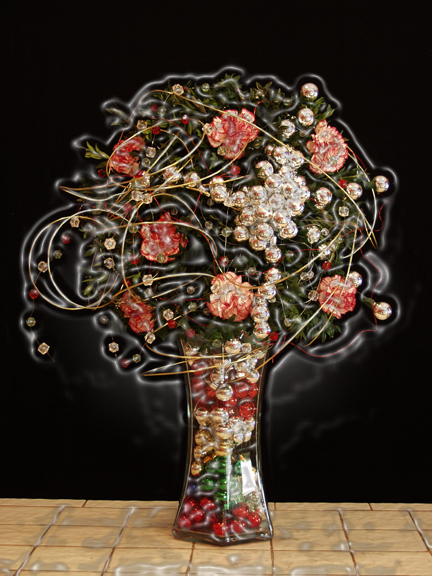|
Some Thoughts About Current Floral Art....By Dr. Stephen Rittner
As a third generation floral designer who has grown up in the floral field, and who has taught this art form for many years, in one of the finest floral training programs in the US, I would like to offer some observations about things I see going on in the world of floral art.
In my opinion, this is probably one of the most fascinating times of history to be a floral artist for a wide range of reasons!
Todays Floral Designing is Incredibly Eclectic

In the 21st Century, the current state of floral designing is quite varied. Practically every single floral design technique that has been developed over thousands of years is still out there, being done by one designer or another. Yet at the same time, floral artists are constantly "pushing the envelope" experimenting with new styles, materials and approaches and pushing our media to the limits.
The overall result is rather schizophrenic, chaotic and wonderful.
This means that designs that were made a thousand years ago, or a hundred years ago or even fifty years ago, (or techniques that were used in these varied designs) are now all co-existing simultaneously.
Perhaps a few examples are appropriate.
Crowns or chaplets of flowers are quite popular for wedding designing, and for small girls hair, etc. Yet we can trace these kinds of designs to the ancient Greeks, Romans, and Egyptians.
Designing in a water base, commonly done by my Grandfather, before the invention of foam is all the rage! And why not? People enjoy the effect of the stems and the natural beauty and informality of these bouquets.
Hand tied spiral round bouquets.......considered very "frou-frou" by the typical bride, are some of the oldest kinds of floral art done on the planet, for they require little contemporary "technology" in their execution. They are abundant, showy and beautiful now as they were hundreds of years ago. And are even more popular today than they were forty years ago.
These are but a few simple examples. I could easily cite many, many more.
Now fast forward to the 21st Century....
All kinds of marvelous approaches to floral designing that my grandfather never dreamed about
 are available to today's floral designer. Terms like zoning, basing, mille de fleur, pave, waterfall floral designing, hedgerow, parallelism, new convention, and more have entered the contemporary floral artist's bag of tricks. are available to today's floral designer. Terms like zoning, basing, mille de fleur, pave, waterfall floral designing, hedgerow, parallelism, new convention, and more have entered the contemporary floral artist's bag of tricks.
New technologies have been enabling floral artists for years. Foam back in the mid 20th Century was only the beginning. Today's foam technology allows the creation of pew decorations in foam bases. It provides pretty foam based plastic holders with metallic finishes, and the use of foams in a rainbow of colors allowing the mechanic itself to become an important part of aesthetic expressions.
Today's floral designer can integrate small self-contained lights with fibre optics into flowers to wear, can create multilevel floral designing that does not have to be retrieved after a party or receptionand yes, can even integrate decorative color wires and flower "jewelry" into their floral designing. Approaches, materials and ideas that Grandpa never dreamed of.
When Grandpa designed in water, he could choose between fancy crystal vases or perhaps the old "green crinkled glass" type of base. The choices available today in both shapes and colors of glassware are infinite.
What a wonderful time to be a floral artist! We continue to have a greater amount of creative options available to us then any prior generation of floral designers....This is great!
There is a Greater Desire For/And Acceptance Of Diversity In The Marketplace
This is true of the marketplace in general.
If you want to buy a car, you have a choice of SUVs, luxury, sports vehicles (and more )
and all kinds of combinations thereof.
If you want to buy a loaf of bread you can get it sliced thin, thick or not sliced at all. You can get it with raisins, with cinnamiin, made with wheat or without wheat, with low calories, with bran and so forth.
If you go online to buy music or into a store that sells cd, again we encounter a wild assortment of kinds of music. Jazz, Classical, Electronic, Dance, Country, Rock....The choices available to the average individual today are amazing.  And why not? And why not?
Manufacturers try to provide solutions to a diverse range of desires.
Why should floral art be any different?
People have diverse tastes and enjoy different things. If different folks can enjoy different kinds of music, it would stand to reason that they can and should enjoy different styles and approaches to floral art. And just as a person can enjoy classical music at one time, and rock on other occasions, it would make sense that a person could vary in their what kind of floral designing would appeal to them at any point in time.
Given that kind of zeitgeist, it is easy to see how diverse styles of floral art and techniques can easily co-exist in the marketplace.
The Term "Contemporary" Now Means Many Things!
In a visual arts field, it is very tempting to casually dismiss last year's so-called look, style or approach. Like other designers, I've often been tempted to react to various styles/approaches that way. But the current eclecticism of floral art, coupled with consumer desire for diversity in expression turns that idea totally upside down.
When a florist creates a wedding with a "Victorian" look, at the request of one customer, then designs something that looks like it came out of a Sci-fi movie for another customer's party, it seems that all of these looks are equally acceptable.
Technically the word "Contemporary" means anything being done at the present time.
Could one argue that a wide range of styles and techniques, many of which can be traced back decades, if not hundreds and thousands of years, are all "contemporary," even as new looks and styles developed only within the past few years are also "contemporary"?
For folks hung up on labels as to what is "in" this year, as opposed to last year, this kind of problem can and does create confusion. What's a person to do?
What Matters Is What People Buying Floral Art Want!
I would suggest that as designers, we approach this issue from a very different point of view.
From a practical view point does it really matter whether the bride wants a bouquet that can be traced back to Elizabethan times or one that was developed in the mid 1900's What does matter is that it's what she wants, and what will meet her needs and make her happy.
In other words smart floral designers are very practical. They realize that there is a constant recycling of floral design ideas, even as there is evolutionary and revolutionary changes constantly being introduced into our art.
Their designing is driven by the demands of their customers and by what sells in their business.

And this is why some shops may carry round mounds created in foam, and others will sell designs in water...why some shops will feature a garden look, and still others "high style." Smart florists are pragmatic. They don't get hung up in theory. They find out what their customers want, and make sure that they meet their needs.
But to be able to do this effectively you have to know what you are doing. That requires real knowledge of floral design and the wide range of techniques and approaches--something you need outstanding training to do well---and that's where we get involved.
People Buy Floral Products And Floral Art To Meet Emotional Needs
Many folks think that floral designers are selling products and services.
That is true. They are.
But florists' products and services are but a means to an end. When that fellow calls the flower shop because he needs flowers to make up with his significant other, he is buying more than just the flowers, or that floral design. He is buying a solution to his problem. That design will hopefully help get him back into her good graces and remind his loved one that he loves her.
Once again you can't offer solutions to needs, unless you are very knowledgeable about the possible solutions, and how to bring them about...and to be able to do that effectively you need outstanding training----and that's where we get involved.
It's Effect On Us As Floral Design Educators At Rittners School of Floral Design....
It is simplistic to think that the floral designer is just sticking a few flowers in a vase, or just selling flowers. The florist who views the field that way is an anachronism. Those kinds of florists don't last very long in today's marketplace.
The smart ones go far beyond that. Floral art is very much a matter of finding solutions for customers problems. This involves how we sell, but just as importantly, what kind of design choices we make for the consumer, and involves a large number of variables such as style, look, color, and various elements of design--and that's something you need outstanding training to do well--and that's where we get involved.
At Rittners Floral School we approach floral designing, as design solutions.....that there are a wide collection of techniques and approaches some classical, some "cutting edge" that one must master in order to meet consumers needs. That makes both the process of teaching (on our side), and of learning (on our students' side) a fascinating one.

We are constantly consulting our graduates and friends in the floral industry, reviewing the literature, watching fads and trends, and adjusting our curriculum accordingly. To make things even more interesting, we are also quite aware that our student body comes to us from most regions of the US as well as abroad, and that students who may originally be from one area, could easily end up living in another part of the nation. Our approach and our curriculum reflects that.
It also means that although all of our courses start simply with no prior background needed, we build advanced concepts into most of our programs (rather than having our students first take "basic" and then more advanced classes) for we know that our students will be far better prepared that way. We feel that it will give them better value.
It makes our job fascinating, for in our Six Month Day Course we could be teaching the round Euro-spiral bouquet with the natural stems hanging out one day (quite the rage with today's brides yet developed centuries ago) and yet the next day teach a pool float design (specialized "cutting edge" arrangement that ressembles a little island for use in outdoor parties around a pool or pond).
The ultimate compliment that I get is when I hear from graduates who have held jobs in various parts of the country is that they are very easily able to adapt to very different shops with very different approaches.
Not all floral training is alike. We take pride that at Rittners, we are on the cutting edge of floral design instruction, and have been for many decades. We are proud of the very unique, practical and modern approach to teaching floral art that we stress at Rittners School of Floral Design.
|